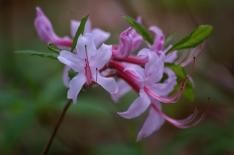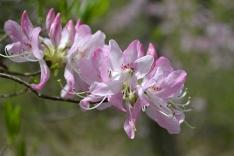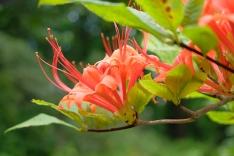
3 minute read
Jenkins Arboretum & Gardens
When we think of azaleas, we often picture evergreen shrubs sporting bright pink blooms at the start of spring. Most of the azaleas we see in our own yards and neighborhoods are the offspring of plants from Asia. But did you know that we have our own native azaleas? Unlike their Asian counterparts, azaleas from the eastern United States are tall, airily deciduous, and flaunt the most exquisite yellow, redorange, pink, or white flowers, many of which are fragrant and bloom into summer. There are 16 species of deciduous azaleas native to the East Coast and all but one (Rhodora - Rhododendron canadense) thrive here in the Philadelphia region. Keep reading to learn more about four of our favorites, all of which you can find growing at Jenkins Arboretum & Gardens.
Pinkshell Azalea (Rhododendron vaseyi) is the first of the native azaleas to bloom in the spring, with delicately spotted pink flowers. It is incredibly rare in the wild, growing in bogs, thickets, and forests in only four counties in North Carolina. Despite its rarity in the wild, it is quite easy to grow in garden settings and provides a welcome dapple of color in early spring for the home gardener.
Advertisement
Pinxterbloom Azalea (Rhododendron periclymenoides) was once prolific in this region and can still be easily found while hiking here in Pennsylvania. The lightly fragrant flowers are typically soft pink, but can be nearly white or even lavender, blooming slightly before the emergence of new leaves in spring. The common name of this species is not a reference to its color. Instead, the name “pinxter” translates to “Pentecost” (the seventh Sunday after Easter) in Dutch and refers to this species' bloom time in the northernmost reaches of its range. Pinxterbloom opens much earlier than Pentecost here in Pennsylvania and is an easy-to-grow showstopper. Swamp Azalea (Rhododendron viscosum) has relatively small, clove-scented, white flowers tinged with pink, blooming in late spring after the leaves have expanded. The name “viscosum” is derived from “viscous”, meaning “sticky” a reference to its sticky, hairy, tube-like flowers. It is a fairly common species and can be seen growing in the wild from Maine to Florida, westward to Texas. As its common name suggests, this species grows best in wet woods, but can tolerate less wet sites with a generous layer of mulch or shredded leaves.
Plumleaf Azalea (Rhododendron prunifolium) is the latest blooming of all the native azaleas, with orangey-red flowers displayed in mid to late summer, well after other azaleas have thrown in the towel. It is quite rare in the wild and may soon be considered an endangered species. Plumleaf azalea generally grows in wooded ravines, along streams, and in mixed forests in the wild, so a site with afternoon shade on your property will help to prolong the bloom period. This is just a sampling of the incredible and breathtaking diversity seen in our native deciduous azaleas. To see these magnificent native azaleas in person, be sure to visit Jenkins Arboretum & Gardens, where more than 1,000 native azaleas are happily thriving. If you decide to add one of these amazing plants to your landscape, remember that all of them are happiest when planted in moist, well-drained, acidic soil with partsun to dappled shade. Full morning sun is ideal, but most of them would suffer in the intensity of midday sun. Drainage is important too, so loose, highly organic soil is recommended, along with a covering of woodchip or shredded leaf mulch. As with most shrubs, don't forget to water regularly and thoroughly until they are established. Many of these azaleas can be purchased at local nurseries specializing in native plants, including the Plant Shop at Jenkins Arboretum & Gardens.
Photos by Chris Swisher, courtesy of Jenkins Arboretum & Gardens.
Jenkins Arboretum & Gardens is a 48-acre public garden showcasing native flora of the eastern United States and a world-class collection of rhododendrons and azaleas. The gardens are open every day of the year and admission is always free. The gardens are completely funded by the community please consider becoming a member to support this special place. Jenkins is located at 631 Berwyn Baptist Road in Devon. 610-647-8870 ¦ jenkinsarboretum.org.




SAVE THE DATE
nd22 Annual Citizens
Police Academy
Please join us for the 2022 Citizens Police Academy happening this Fall.
stRegistration opens August 1 . Contact Officer Joe Butler, Director of Community Policing jbutler@tredyffrin.org or 610-408-3654







